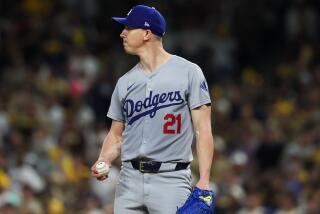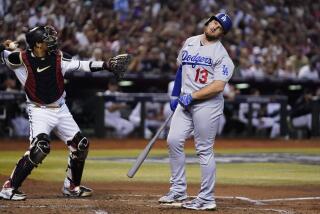Baseball ’90 PREVIEW : Anatomy of a Pitch : HOW SPIN AFFECTS FLIGHT
Over the years, there have been a number of theories on why pitches move the way they do. One theory, in fact, contended that pitches don’t break at all, rather it is an optical illusion. However, researchers have more recently concluded that aerodynamics play an integral part as the air, spin, speed and direction of the ball from its release point all converge.
The underspin of a fastball (left) forces air downward, causing the ball to rise on a wedge of built-up air while the spin helps to roll away air above the ball.
Breaking pitches (right) utilize the same principles to gain sideways and downward arc from the forward spin of the ball. The knuckler, which has very little rotation, is unpredictable in its movement because it responds to fluctuation air conditions.
FASTBALL
Rising fastball, the Koufax specialty. Held across two wide seams (pitches held across seams gain rotation and speed). Fairly straight, but rises because of velocity and backspin. This is the standard fastball. Movement depends on slight variations of grip and delivery. Speed is generated mostly from the legs, the whipping motion of the arm, and wrist snap. “I’ll take movement over velocity,” said Dodger pitching coach Ron Perranoski. “I’ll take a guy who throws 88 miles per hour with movement over a guy who throws 90, straight. Then again, I’d like to work with the guy who throws 90.”
Sinking fastball, a la Hershiser. Held with or across the two narrow seams, with pressure applied by the index finger. Bites down and away because of diagonal overspin created by staying on top of the ball. Can be run up and in by change of hand angle.
Cut fastball: Overloading pressure of middle finger forces ball to sail in on hitter. A left-hander uses it to pitch in on a right-handed batter, a right-hander uses it to pitch in on a left-handed hitter.
BREAKING PITCHES
Curve: Speed of the curve can be varied by arm speed and tightness of grip. There are also a variety of grips and arm angles that alter the angle at which the curve breaks. Almost all are thrown with topspin to create a downward break as contrasted to a slider, which breaks across the plate. A straight overhand curve of the Koufax variety has a limited strike zone because it generally breaks between the waist and knees, producing more swinging strikes than called strikes. Typically, curves are about 10 miles per hour slower than a fastball.
Slider: The slider is thrown by overloading the middle finger across the narrow seams. It is thrown like a football with the arm speed of a fastball, good extension and a snap at the end. A Tom Seaver and Steve Carlton specialty, it produces the look of a fastball with a sharp break; down and in from a right-hander to a left-handed batter; down and away from a right-hander to a right-handed batter. Its speed is generally 4 to 5 miles per hour slower than the fastball. A curve is generally 10 mph slower than the fastball with a bigger arc than the slider.
Changeup: Thrown with the deceptive arm speed of a fastball. There are also changeups thrown off the curve. velocity is altered by the grip. There are a variety of changeups, including the palmball, three finger and circle change, in which the index finger is curled inside the thumb and placed at the side of the ball, with the middle, fourth and little fingers on top of the ball. Frank Viola, who has one of the best changeups among active pitchers, throws a circle change. The changup is used frequently by pitchers behind in the count, when the hitter is sitting on the fastball. It is considered an ‘out’ pitch with the goal of catching the hitter off balance and on his front foot, resulting in an easy ground ball or pop-up. San Francisco Manager Roger Craig: “Unless you have an overpowering fastball like Ryan or the movement of a Hershiser, you’ve got to be able to throw a breaking ball or off-speed pitch when you’re behind on the count.”
SPLIT-FINGER
Thrown by placing the ball comfortably in the split between index and middle fingers and delivered with a fastball motion. Some can throw it with the same velocity of a fastball. For others, it is more of a changeup. Even if straight it has the effect of an off-speed pitch since the hitter sees the same motion, arm speed and rotation of the fastball, generally without the same velocity, which, in turn, can produce a break that is reminiscent of a spitball--the ball, in the vernacular, dropping off a table. Those who dislike the split-finger contend that constant use--like with any other pitch--seems to deprive a pitcher of the velocity needed for his fastball when he needs his best velocity in a strikeout situation.
SCREWBALL
The screwball is a breaking pitch that a right-hander can throw effectively to a left-handed batter and a left-hander can throw effectively to a right-handed batter because in those situations it breaks down and away from the hitter. The ball is generally gripped without use of the seams, the thumb underneath and the index and middle fingers together on top, the ball resting in the front half of those fingers. It is delivered from a three-quarter or overhand motion with an inward snap of the arm to create the reverse and off-speed break. It had been the bread and butter pitch of Fernando Valenzuela. Among the pitchers who throw it effectively, it often replaces the curve. However, it is considered one of the most stressful pitches on the arm because of the reverse motion and snapping the ball away from your body rather than with it.
KNUCKLEBALL
Made famous by Hoyt Wilhelm and the Niekro brothers, it is a pitch that can be thrown by people without strong arms, but requires extensive training to help keep it under some control. The pitch is difficult to hit and just as difficult to catch. It is generally held by digging the fingertips into the ball and delivered almost with a pushing motion. The movement is inconsistent and speed is as slow as 60 mph. On approach to the plate, the ball breaks at different points, its movement is lateral and vertical and there is almost no spin on the ball. However, like Charlie Hough, most pitchers who throw it successfully have built up calluses on their fingertips, which help them dig into the ball firmly.
More to Read
Go beyond the scoreboard
Get the latest on L.A.'s teams in the daily Sports Report newsletter.
You may occasionally receive promotional content from the Los Angeles Times.










